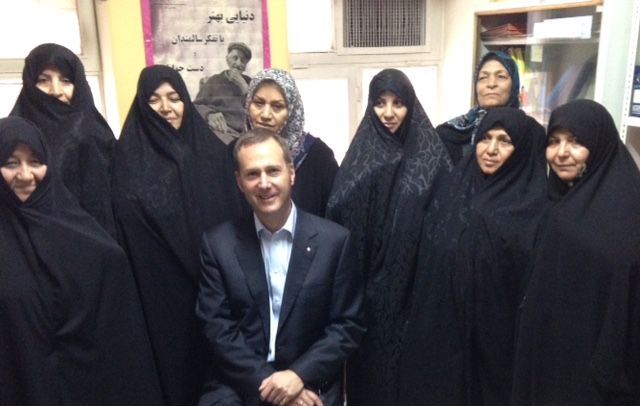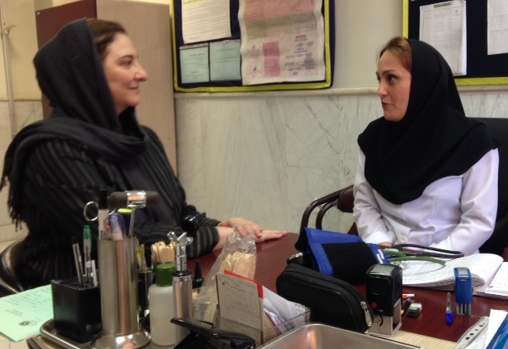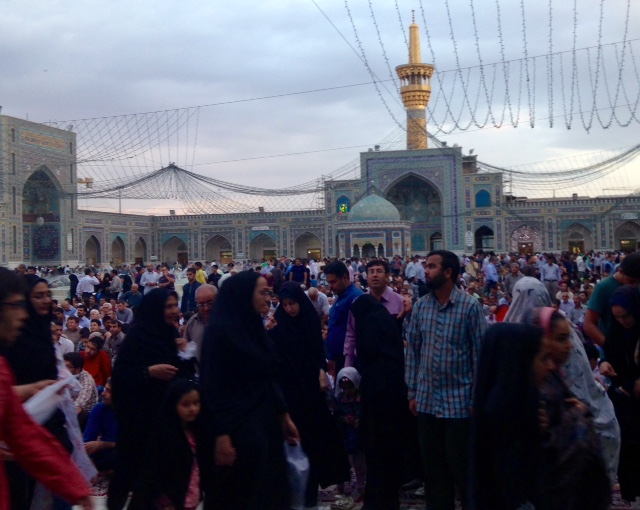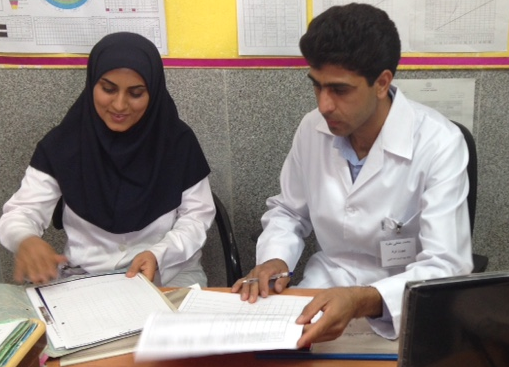From the President: Perspectives on Iran
 Photo: WONCA president with group of health volunteers at Torab primary health care centre in Tehran
español
Photo: WONCA president with group of health volunteers at Torab primary health care centre in Tehran
español

Dr Samira Pouryosefi is a family doctor working in the Zar nan rural health centre in the Islamic Republic of Iran. As the head of her local primary health care team, Samira is responsible for the health and well being of over 4,700 people living in her rural town and the surrounding region. Samira also works with the community health workers, called behvarz, who run the small health clinics, called health houses, in the surrounding rural villages.
Photo: Family doctor, Dr Samira Pouryosefi (right) in her clinic at the Zar nan
rural health centre in the Islamic Republic of Iran (with WHO Iran lead
and family doctor, Dr Jihane Tawilah)
I
was visiting Iran as a member of a mission for the World Health Organization (WHO) examining the integration of health services with medical education across the country. As part of the mission I had the opportunity to visit the capital city of Tehran, in the north of the country and dominated by the Alborz Mountains, the city of Mashhad, built on an oasis on the former Silk Road and most famous for the tomb of Imam Reza, visited each year by millions of pilgrims, the former royal city of Isfahan, former capital of Persia, designated by UNESCO as a World Heritage Site for its outstanding examples of Iranian and Islamic architecture, including palaces and mosques and bridges, and a number of rural towns and villages.
 Photo: Inside the Imam Reza mosque complex in Mashhad
Photo: Inside the Imam Reza mosque complex in Mashhad
Iran has a population of 78 million people, with 12.5 million people living in the capital city, Tehran. It is the 18th largest country in the world and one of the world’s most mountainous countries. 30% of the population lives in rural areas.
The success of primary health care in Iran is world-renowned. Iran is one of the country’s that has successfully tackled universal health coverage through the training and support of a nationwide network of community health workers, know in Persian (Farsi) as behvarz. The behvarz are people from rural communities who work to link their population to the doctors and nurses working in local health units. Each behvarz operates from a small clinic, called a Health House, based in their local village. There are 14,000 Health Houses across the country. Some behvarz work alone, others in pairs, often a husband and wife team. Their work is especially focused on maternal and child health, vaccination programs, prevention of infectious diseases, sanitation, first aid and family planning. The behvarz know everybody in their local community, conduct home visits for the newborn, the elderly and those with disability, and keep records on a chart in each Health House, known as a Health Horoscope, which provides a quick and easily updated summary of the health status of all the people in each community. Between 1984 and 2000 Iran was able to halve its infant mortality rate, raise immunization rates from 20% to over 95%, and implement a highly successful program of family planning. Public primary care services are provided free of charge.
 Photo: Behrvarz Samantha Amir-Torbati and behrvarz Mohammad Eahgh, in their
rural health house outside the city of Mashhad (note Health Horoscope on
the wall behind)
Photo: Behrvarz Samantha Amir-Torbati and behrvarz Mohammad Eahgh, in their
rural health house outside the city of Mashhad (note Health Horoscope on
the wall behind)
To extend the work of the behvarz in rural areas, the government of Iran has also created a program of urban-based health volunteers, mainly women, called Davtalab Salamat (the Farsi term for Health Bridge). The health volunteers work with the members of their local communities, based out of urban primary care centres.
Iran is also famous for the integration of medical education and public health services. In 1985 the nation created a single Ministry of Health and Medical Education. The Chancellor of each University of Medical Sciences in the country is responsible not only for the education of health professionals and medical research, but also for the clinical services delivered through public hospitals and primary health care services within their assigned geographic region. This allows far greater integration between the functions of universities and health services, than exists in many other countries. Some of the Chancellors are responsible for the health care services provided to over 5,000,0000 people.
As health care measures have improved, Iran has recognized the need to strengthen primary care through the creation of the specialty of family medicine, and WONCA is providing support to the country to develop formal training for the family medicine workforce. The lack of a recognised specialty of family medicine has meant that most medical graduates have been training to become hospital-based specialists and sub-specialists. High public demand for health services in teaching hospitals, and self-referral, has led to excessive demand for hospital-based clinical services, lengthy waiting lists and rising health care costs. At the same time the prevention and management of chronic health conditions has been less than optimal. As in many countries, family medicine is recognised as the solution to these common health system challenges. President-elect, Professor Amanda Howe, has recently visited Iran, again with the WHO, to assist with the development of postgraduate family medicine training. Iran is not yet a member of WONCA but we look forward to welcoming our colleagues from Iran into the WONCA family.
 Photo: WONCA president receiving membership application from Dr Faramarz
Rafiee from the Iranian Society of General Practitioners, with Dr Saeed
Taammali, general practitioner advisor to the Iranian Minister of
Health and Medical Education
Photo: WONCA president receiving membership application from Dr Faramarz
Rafiee from the Iranian Society of General Practitioners, with Dr Saeed
Taammali, general practitioner advisor to the Iranian Minister of
Health and Medical Education
This was an interesting time to be in Iran, with the United Nations having recently announced a nuclear accord that could lead to the lifting of long-standing sanctions. I admit that I was a little nervous about visiting Iran, especially when told that I would have to undertake advanced security training through the United Nations. Once in Iran, I felt welcome and safe. The people I met were welcoming, friendly and very hospitable. The cities were clean and green. The cultural heritage is remarkable and I enjoyed learning about the country’s history. It took me two days to realise that my group was accompanied by a discrete security detail of two military-trained paramedic officers driving their ambulance behind us as we moved around the country.
Michael Kidd
WONCA President
Isfahan Photo Gallery